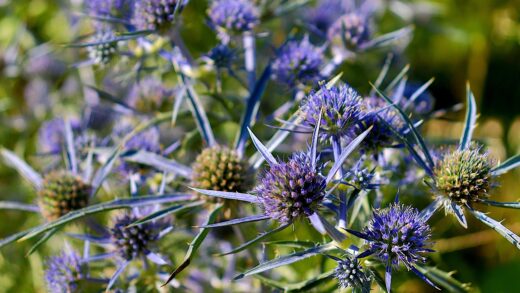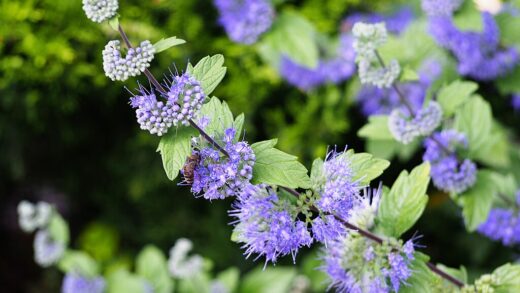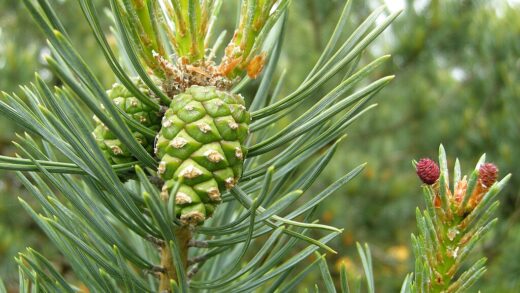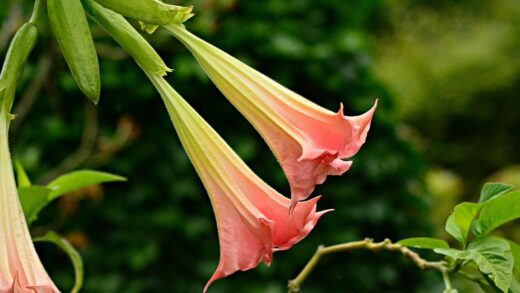Successfully establishing a new bluebeard shrub in your garden begins with thoughtful planting, a process that lays the groundwork for years of beautiful, late-season blooms. The ideal time to plant Caryopteris is during the spring, after the last threat of frost has passed, as this allows the plant the entire growing season to develop a robust root system before facing its first winter. Alternatively, early autumn planting can also be successful in milder climates, giving the roots time to establish while the soil is still warm. Proper site selection and soil preparation are paramount; this shrub demands a location with full sun and, most importantly, soil that offers excellent drainage to prevent the root rot to which it is particularly susceptible. Careful attention to these initial steps is the most significant investment you can make in the long-term health and vitality of your plant.
The first step in the planting process is to prepare the planting hole itself, which should be designed to give the young shrub the best possible start. Excavate a hole that is approximately twice as wide as the plant’s root ball but only as deep as the root ball itself. Planting the shrub too deeply can lead to crown rot and other issues, so it is crucial that the top of the root ball is level with or slightly above the surrounding soil surface. This wider hole provides loosened soil on all sides, encouraging the roots to spread outwards into the native soil rather than remaining confined within the original planting hole.
Before placing the plant in the hole, it is beneficial to amend the soil that was removed. If you are working with heavy clay soil, incorporating organic matter like compost, coarse sand, or fine pine bark will significantly improve its drainage and structure. For sandy soils, adding compost or peat moss will help to increase its ability to retain moisture and nutrients. Mix these amendments thoroughly with the excavated soil before using it to backfill the hole. This creates a transitional zone that helps the plant’s roots adapt more easily from the potting medium to the garden soil.
Once the hole is prepared, carefully remove the Caryopteris from its nursery container. Gently loosen any roots that are tightly wound or circling the bottom of the root ball, as this encourages them to grow outwards into the new soil. Place the plant in the center of the hole, making sure it is standing upright and that the top of the root ball is at the correct depth. Begin backfilling the hole with the amended soil, firming it gently around the roots to eliminate any large air pockets. Avoid compacting the soil too heavily, as this can impede water and air movement.
After the hole has been completely backfilled, create a shallow basin or “well” of soil around the perimeter of the planting area. This small berm will help to direct water to the root zone and prevent it from running off, ensuring the plant receives adequate moisture. Water the newly planted shrub thoroughly and deeply immediately after planting to settle the soil around the roots and to provide essential hydration. This initial watering is critical for helping the plant to overcome transplant shock and begin the process of establishing itself in its new environment.
Propagation through softwood cuttings
Propagating Caryopteris is a straightforward and highly effective process, most commonly achieved through softwood cuttings taken in late spring or early summer. This method allows you to create new plants that are genetically identical to the parent, ensuring that desirable traits like flower color and compact habit are preserved. The ideal time to take these cuttings is when the new growth is still flexible but mature enough to snap when bent sharply. This stage of growth typically occurs from May to July, providing the cuttings with the best chance of successful rooting.
To begin, you will need a healthy parent plant, a sharp, sterilized pair of pruning shears or a knife, a pot or tray filled with a suitable rooting medium, and a rooting hormone powder. The rooting medium should be light and well-draining; a mixture of half perlite and half peat moss or coir is an excellent choice. Moisten the medium thoroughly before you begin, allowing any excess water to drain away. Having your materials prepared in advance will ensure that the cuttings can be processed quickly, minimizing the time they are exposed to the air and reducing the risk of them drying out.
Select a healthy, vigorous stem from the parent plant that has no signs of flowers or buds. Using your clean cutting tool, take a cutting that is approximately 10-15 centimeters long, making the cut just below a leaf node (the point where a leaf emerges from the stem). Carefully remove the leaves from the lower half of the cutting, ensuring that at least two or three sets of leaves remain at the top. This is important because the roots will form from these submerged leaf nodes, while the remaining leaves will continue to photosynthesize and provide energy for root development.
Once the cutting is prepared, dip the cut end into a rooting hormone powder, tapping off any excess. While Caryopteris often roots without it, using a rooting hormone can significantly increase the success rate and speed up the rooting process. Use a pencil or a dibber to create a hole in the moistened rooting medium, then insert the cutting into the hole, ensuring the lower leaf nodes are buried. Gently firm the medium around the cutting to provide support. To create a humid environment that encourages rooting, you can cover the pot with a clear plastic bag or place it in a propagator.
Propagation from semi-hardwood cuttings
Another reliable method for propagating bluebeard is by taking semi-hardwood cuttings later in the growing season. This technique is typically performed from mid-summer to early autumn when the current season’s growth has started to mature and become slightly woody at the base, while the tip remains soft. These cuttings are generally more robust than softwood cuttings and may be less prone to wilting, making them a good option for gardeners in warmer climates. The process is very similar to taking softwood cuttings but is adapted for this more mature wood.
When selecting your material for semi-hardwood cuttings, look for healthy stems from the current year’s growth. The ideal cutting will have a firm base but a soft, actively growing tip. Using a sanitized cutting tool, take a section of stem that is about 15-20 centimeters in length. It is often beneficial to include a “heel” with the cutting, which is a small piece of the older, main stem attached to the base of the cutting. This is achieved by carefully tearing the side shoot away from the main stem, and the heel is thought to contain hormones that can encourage better rooting.
Preparing the semi-hardwood cutting follows the same principles as with softwood cuttings. Trim the base of the cutting just below a leaf node and remove the leaves from the bottom two-thirds of the stem, leaving a few leaves at the top to provide energy for the new plant. If the remaining leaves are very large, you can cut them in half horizontally to reduce moisture loss through transpiration. This is particularly important as semi-hardwood cuttings can take a bit longer to root, and minimizing water stress is key to success.
After preparing the cutting, dip the base in rooting hormone and insert it into a pot filled with a well-draining rooting mix, such as a blend of compost and sharp sand or perlite. Water the medium well and place the pot in a sheltered location that receives bright, indirect light, such as a cold frame, a greenhouse, or a windowsill out of direct sun. Maintain consistent moisture in the rooting medium, but avoid making it waterlogged. Roots typically begin to form within four to eight weeks, and you can test for this by giving the cutting a very gentle tug; if you feel resistance, roots have started to grow.
Division and seed propagation
While taking cuttings is the most common and reliable method for propagating Caryopteris, it can also be propagated by division, although this is less frequently practiced. Division is best performed on mature, well-established clumps in the early spring, just as new growth is beginning to emerge. This method not only creates new plants but can also be used to rejuvenate an older, overgrown shrub that may have become less vigorous or has developed a dead center. It is a more physically demanding method but can yield several new plants at once.
To divide a Caryopteris, you must first carefully excavate the entire plant from the ground, taking care to preserve as much of the root ball as possible. Once the plant is lifted, use a sharp spade, an old saw, or a large knife to slice the root ball into several sections. Each section should have a healthy portion of the crown and a good number of roots attached. The size of the divisions will depend on the size of the parent plant and how many new plants you wish to create. It is important to work relatively quickly to prevent the roots from drying out during the process.
After dividing the clump, inspect each section and trim away any damaged or dead roots with clean pruners. You can then immediately replant the divisions into their new locations in the garden or into pots. Treat them as you would a new plant, ensuring they are planted at the correct depth in well-prepared soil. Water them in thoroughly after planting and keep them consistently moist for the first few weeks to help them recover from the shock of the process and encourage new root growth.
Propagation from seed is also possible, though it is not the preferred method for hybrid cultivars like Caryopteris x clandonensis. This is because seeds from hybrids may not grow true to the parent plant, meaning the resulting offspring could have different characteristics in terms of flower color, size, or habit. Furthermore, some modern cultivars are sterile and produce no viable seed at all. If you do wish to try growing from seed, collect the seed heads in the autumn after they have dried on the plant. Sow the seeds in a tray of seed-starting mix in the spring, lightly covering them with soil and keeping them moist until germination occurs.
Post-planting and aftercare
The care provided to a bluebeard shrub immediately after planting and throughout its first year is crucial for its long-term success. Consistent watering is the most important aspect of this aftercare. For the first few weeks after planting, check the soil moisture every few days and water deeply whenever the top few inches of soil feel dry. The goal is to keep the root zone consistently moist but not saturated. This encourages the roots to grow deep into the soil, which will make the plant much more drought-tolerant in the future.
As the plant begins to establish itself over the first growing season, you can gradually reduce the frequency of watering. However, it is still important to monitor the plant during hot, dry periods and provide supplemental water as needed. A good rule of thumb is to provide a deep watering once a week during the summer months if there has been no significant rainfall. Applying a two to three-inch layer of organic mulch, such as shredded bark or compost, around the base of the plant can be highly beneficial. Mulch helps to conserve soil moisture, suppress weed growth, and regulate soil temperature.
During its first year, it is best to avoid fertilizing a newly planted Caryopteris. The amended soil at planting time should provide sufficient nutrients for its initial establishment. Adding fertilizer too soon can force rapid, weak growth and can potentially burn the new, sensitive roots. It is better to allow the plant to focus its energy on developing a strong root system rather than excessive top growth. You can begin a conservative feeding regimen in its second year if your soil is particularly poor.
Patience is key during the first year of a Caryopteris’s life in your garden. The plant will be dedicating a significant amount of its energy to establishing its roots, so you may not see explosive top growth or a huge number of flowers in the first season. This is completely normal. By providing consistent water, mulching, and avoiding excessive fertilization, you are creating the ideal conditions for the shrub to build the strong foundation it needs to thrive and produce a spectacular floral display for many years to come.




















